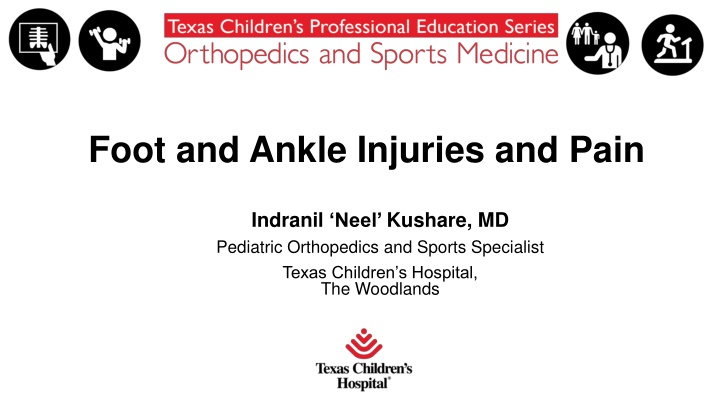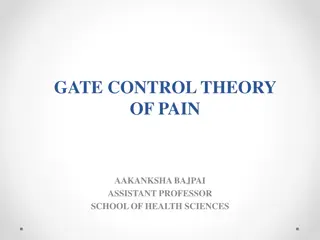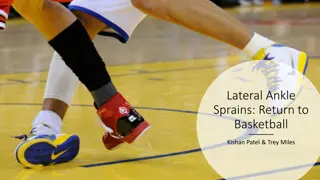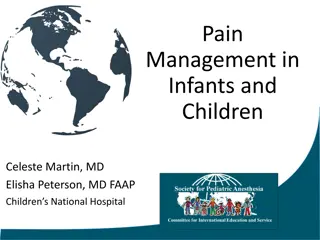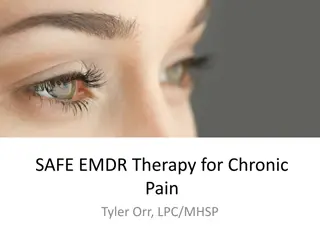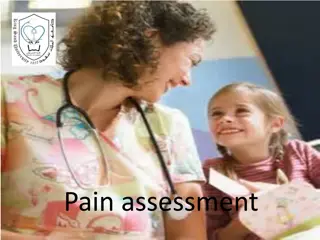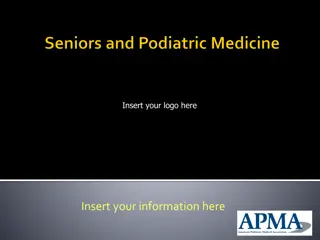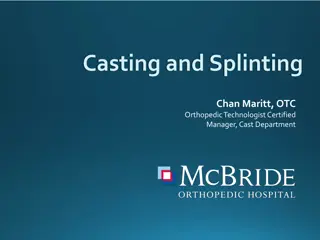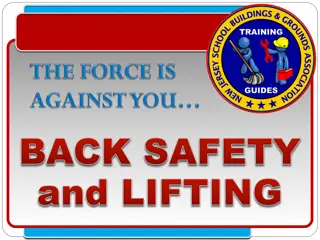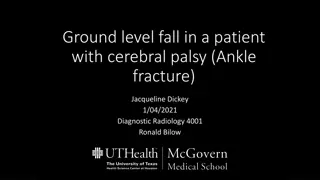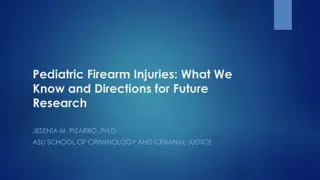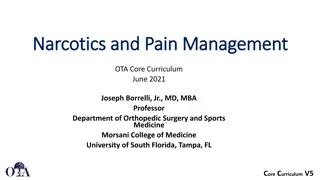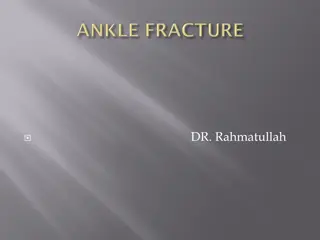Ankle Injuries and Pain Overview - MD Pediatric Orthopedics
Explore the causes, types, and treatment of ankle injuries and pain, focusing on sprains, fractures, and impingement issues. Discover insights on ankle sprains in children and adults, ligament anatomy, common injury mechanisms, and essential ligaments involved. Gain valuable information on distinguishing factors between pre-adolescent and adult ankle injuries.
Download Presentation

Please find below an Image/Link to download the presentation.
The content on the website is provided AS IS for your information and personal use only. It may not be sold, licensed, or shared on other websites without obtaining consent from the author.If you encounter any issues during the download, it is possible that the publisher has removed the file from their server.
You are allowed to download the files provided on this website for personal or commercial use, subject to the condition that they are used lawfully. All files are the property of their respective owners.
The content on the website is provided AS IS for your information and personal use only. It may not be sold, licensed, or shared on other websites without obtaining consent from the author.
E N D
Presentation Transcript
Foot and Ankle Injuries and Pain Indranil Neel Kushare, MD Pediatric Orthopedics and Sports Specialist Texas Children s Hospital, The Woodlands
Overview 1. Ankle sprains 2. Ankle fractures 3. Ankle impingement ( and other differentials of foot and ankle pain)
A stretch or tear of one or more ankle ligaments. Once the ligaments stretch beyond its natural range, a sprain will occur Ankle Sprain 1 sprain per 10,000 per day Most common ligamentous injury Most common reason for missed athletic participation
Can a 7 year old child sprain is ankle? Is it easier for an adult or child to sprain their ankle?
Up for Debate! Pre adolescent children still have open growth plateswhich are the weakest part of their ankle . Children do NOT sprain or tear their ligaments as easily as adults. The reason is that in children the weakest part of their bone anatomy is the growth plates (physis). The ligaments in children are stronger and so when they twist their ankles the bone usually separates
Ankle is a Hinged Joint Mortise=
90% caused by planter flexion with inversion injure the ATFL Syndesmosis injury (high ankle sprain) more common with eversion and/or external rotation of ankle during injury
Anatomy of Ankle Ligaments Fibular collateral ligament consist of the following 3 structures. These are weaker than the medial ligaments, since the fibula also helps support the ankle Anterior talofibular ligament (ATFL) Calcaneofibular ligament (CF) Posterior talofibular ligament (PTFL) Deltoid Ligament medial
History How did injury occur? Mechanism of injury: inversion vs eversion of ankle Where you able to bear weight/walk afterwards? Any popping/snapping? Altered sensation? Throbbing? Pain? Medication use? Swelling? Any care performed already? Interventions?
Physical Exam Inspect Skin color, edema, ecchymosis, Palpate over bony and ligamentous landmarks Assess Passive and Active Range of Motion Tests: Ambulate? Toe raises? Anterior Drawer Inversion/Eversion Internal/External rotation
Anterior Drawer Test Secure the distal leg with one hand and apply an anterior pull on the heel with the foot held in gentle plantar flexion Positive if patient will have pain, anterior translation and/or clunk indications ATFL injury/rupture
Tests To Asses for a High Ankle Sprain: Squeeze Test in the absence of a fracture, mid-calf compression of tibia and fibula, causes pain at the syndesmosis.
Radiographs Indications to obtain X-rays Inability to bear weight Medial or lateral point tenderness 5th metatarsal tenderness Navicular tenderness Not always necessary if there is no bone tenderness and patient is walking comfortably 3 AP Lateral Mortise views of ankle If on exam suspicious for additional fractures, obtain appropriate films (tib/fib, foot etc)
Normal Radiograph Findings of Closed vs Open Physis
Additional Imaging MRI: helps evaluate ligament and syndesmotic injuries if needed Not predictive of instability Maybe used for high-level athlete to give better estimate of return to sport Not often used in typical ankle sprain May consider if pain persists 8 weeks after sprain
Types of Ankle Sprains High Ankle Sprains syndesmosis injury, 1- 10% of all sprains, interossoeous membrane between the tibia and fibula is involved/injured Low Ankle Sprains ATFL and CFL injury, > 90% of ankle sprains
Classification of Low Ankle Sprains Ecchymosis and Edema Pain with Weight Bearing Ligament disruption Grade 1 None Minimal Normal Grade 2 Stretch without tear Moderate Mild Grade 3 Complete tear Severe Severe From Orthobullets.com/foot-and-ankle/7028/low-ankle-sprain
Non-Operative Treatment For Grade I, II, III Sprains RICE (Rest, Ice, Compression, Elevate) Rest Depending on severity, may require short period of weight bearing with immobilization ace wrap, aircast or walker boot (However, early mobilization facilitates better recovery) If a high ankle sprain and patient has instability on stress testing patient may be NWB in cast x 4 weeks, then walking cast/boot for 2-4 weeks Ice first 72 hours most important Compression Ace wrap or immobilization device Elevate (Toes above nose) A functional ankle brace (lace up ankle brace) is often helpful during strengthening period and maybe during sport/activity thereafter
Operative Management If associated tibia or fibula fracture Continued instability, despite extensive non-operative treatment
Therapy Activities Once edema and pain have subsided and patient as full range of motion, may begin strengthening and proprioception rehab Passive and Active Range of Motion and Strengthening Therabands Proprioceptive Activities Balance single leg stand, advance to with eyes closed Wobble Board Trampoline Lateral Shuffle Functional Progression back to sport/activities Earlier rehab allows for quicker return to activity/sport
Long Term Estimated 10-30% incidence of functional instability often related to incomplete or inadequate treatment and rehab If an ankle sprain is not recognized, and is not treated with the necessary attention and care, chronic problems of pain and instability may result
Prevention The best way to prevent ankle sprains is to maintain good strength, muscle balance and flexibility Warm-up before doing exercises and vigorous activities Pay attention to walking, running or working surfaces Wear good shoes Pay attention to your body s warning signs to slow down when you feel pain or fatigue
Epidemiology Physeal Injuries About the Ankle Constitute 10-25% of physeal injuries Most common between the ages of 10 15 Distal tibial epiphyseal fractures second only to those in the radius High risk of growth arrest
Distal Tibial Physeal closure Begins in the midportion medially and posteriorly laterally
Anatomy (contd) All major ligaments (except the interosseous) either insert or originate on the distal tibial or fibular epiphyses Ligaments are stronger than the physes
Salter-Harris Dias and Tachdjian
Ankle Impingement ANTERIOR Pinching of structures at front of the ankle Associated with ankle sprains POSTERIOR Pinching of structures at back of the ankle
Posterior Ankle Impingement Under diagnosed cause of posterior ankle pain related to entrapment of soft tissue or osseous anatomical structures in the hindfoot Commonly presents in athletes in plantar flexion-predominant sports with chronic posterior ankle pain exacerbated by plantarflexion or activity E.g., ballet, gymnastics, soccer, running
With Forceful Ankle Plantar Flexion Nutcracker Effect to the Structures in the Posterior Ankle and Subtalar Joints
Causes of Posterior Ankle Impingement A. Os Trigonum syndrome B. Stieda process C. Downsloping of the posterior tibia D. Fracture of the lateral tubercle of posterior process of talus E. Prominent superior calcaneus (Haglund deformity) F. Inflammatory SOFT tissue avulsion fracture of posterior G. Ankle sprain talofibular ligament 2 impingement
Soft Tissue Impingement Don t Underestimate! Posterior capsule and ligaments inflamed, thickened and hypertrophied FHL sheath Accessory ligament, the posterior intermalleolar ligament (PIML)- identified it in 56% of cadaver specimens X-rays are often NORMAL!!
Case 1 13 y.o. female, basketball player First seen by PCP: December 2014 First seen by specialist: December 2015 Number of years experiencing pain: TWO Number of X-rays: 3 Advanced Imaging: 1 MRI Specialties seen: Sports medicine (7 visits), physical therapy (15 visits) Diagnoses: Sever s apophysitis, Achilles Tendonitis, calf tightness, hip weakness, calcaneus - old injury (Abnormal MRI)
Case 2 14 y.o. female, gymnast First seen by PCP: November 2015 First seen by specialist: February 2016 Number of years experiencing pain: >1 Specialties seen: Next slide Number of X-rays: 8 Advanced Imaging: 2 MRI Diagnoses: Chronic regional pain syndrome, peroneal tendonitis, atrophy of R ankle, ankle sprain, sural nerve block for possible sural neuropathy vs peroneal brevis tendinopathy, stress reaction Inability to cope
Specialties Seen Orthopedics (5 different orthopedic surgeons) Sports medicine (2 visits) Physical therapy (15+ visits) Pain medicine (4 visits) Sural nerve block complete atrophy of skin, muscles and soft tissues around the sural nerve distribution Psychologist! (5 visits) Number of X-rays: 8 Advanced Imaging: 2 MRI Diagnoses: Chronic regional pain syndrome, peroneal tendonitis, atrophy of R ankle, ankle sprain, sural nerve block for possible sural neuropathy vs peroneal brevis tendinopathy, stress reaction inability to cope
Case 3 14 y.o. male, soccer player Side of injury: Right + Left First seen by specialist: December 2014 Number of years experiencing pain: TWO Specialties seen: Orthopedics (6 visits), sports medicine (2 visits), physical therapy (15+ visits) Number of X-rays: 7, Advanced Imaging: 3 MRI, 1 CT Diagnoses: Possible osteochondritis dissecans lesion, Chronic regional pain syndrome, Deconditioned ankle, ankle sprain
Case 4 8 y.o. subluxating peroneal tendons and ankle pain Scheduled for groove deepening surgery
Similarities? All patients had the exact same clinical finding: Joint pain posterior to lateral malleolus which correlates exactly to the site of pathology as seen in the MRI Exquisite tenderness over the posterior ankle joint over talar process In front of the Achilles not Achilles tendinitis) Not on the Achilles insertion (not SEVERS DISEASE) Not laterally (no peroneal tendinopathy/ankle sprain)
Similarities? For all patients, pain was completely relieved with rest Pain exacerbated by activity and young athletes could not continue sports activities X-ray imaging for read normal and MRI findings for all patients demonstrated the very similar findings Each patient had experienced pain for at least 1-2 years prior to being treated by an orthopaedic surgeon Each patient visited with a large number and variety of health specialists while seeking treatment for their various underlying conditions
Case 3 Bone marrow edema near the posterior ankle 44
Treatment Conservative Conservative treatment has been empirically recommended Efficacy has not been well documented Review of the literature suggests that little new information has been published in the past 3 decades
Treatment Conservative Steroid and local anesthetic injections are often employed to reduce inflammation and pain Hamilton would not inject because of the vicinity of the tibial nerve In Calder s series of soccer players, all 28 patients had at least 1 injection (average 2; range 1 5) before surgery Marotta would not use steroid injections because of the risk of tendon rupture
Treatment Surgical Van Dijk, in 2000, two-portal minimally invasive arthroscopic treatment
Two Poke Hole Incisions Before : Pain in the Os After: Pain in the Os, no more ! 50
